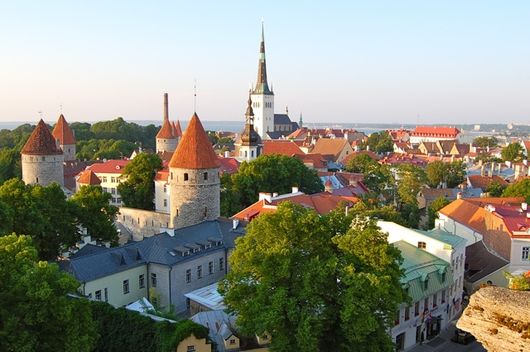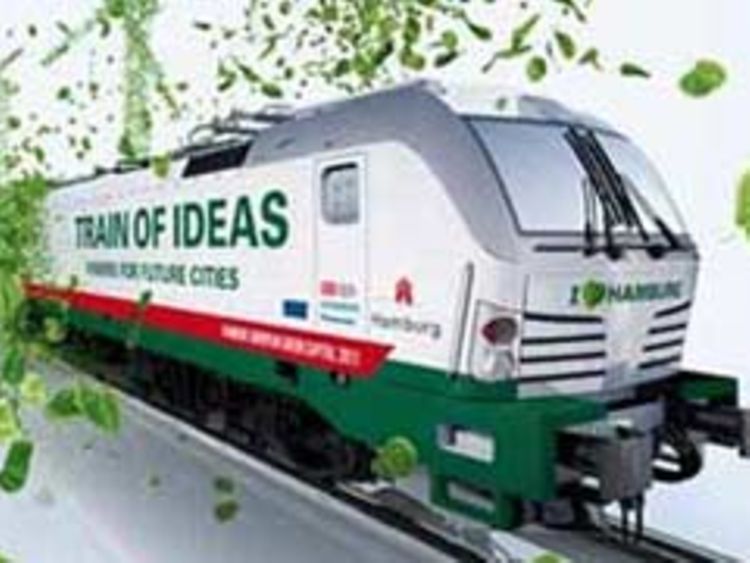.jpg)
2006 lud der damalige Tallinner Bürgermeister Jüri Ratas europäische Amtskollegen ein, um das Projekt auf den Weg zu bringen. Kurz zuvor hatte sich Tallinn um den Titel der Europäischen Kulturhauptstadt beworben und das brachte Ratas auf die Idee, etwas Ähnliches für die Umwelt anzustoßen. Jetzt schließt sich der Kreis: Hamburg als Umwelthauptstadt Europas 2011 stattet der Kulturhaupstadt Tallinn mit dem Zug der Ideen einen Besuch ab.
Kulturprojekte sensibilisieren für Nachhaltigkeit
.jpg)
Einige Projekte des Kulturjahres schaffen die Verbindung zwischen Kultur und Nachhaltigkeit: Das Theater NO99 zum Beispiel zeigt Aufführrungen in einem mit Hilfe der Stadtbewohner errichteten Gebäude aus Stroh. Beim Performanceprojekt „MIM goes sustainable“ müssen die Zuschauer auf Fitnessrädern selbst Strom erzeugen, damit die Bühnenbeleuchtung funktioniert. Und im Langzeitprojekt „Arche Noah von Tallinn“ fertigen Künstler hunderte Holztiere aus aller Welt, um auf gefährdete Arten hinzuweisen.
Erste Anlage für thermische Abfallverwertung in Estland
Vielleicht wird Tallinn irgendwann auch den Titel der Umwelthauptstadt anstreben, doch noch ist die Stadt nicht soweit: Der öffentliche Nahverkehr muss zunächst ausgebaut werden, ebenso die Fahrrad-Infrastruktur. Auch bei der Abwasserklärung und der Abfallbehandlung hat Tallinn Nachholbedarf. Bis 2012 soll in der Nähe der Hauptstadt die erste Anlage zur thermischen Abfallverwertung in Estland entstehen. Sie wird pro Jahr 220.000 Tonnen Haus- und Industriemüll verfeuern. Auch Krankenhausabfälle, deren Entsorgung bislang Probleme bereitet, sollen dort verbrannt werden.
Der Blogeintrag zur Station

Summit of the european capitals in Tallinn
Tallinn is European Capital of Culture 2011 and now welcomes the European Green Capital 2011 - Hamburg. Within its very varied program Tallinn presents our exhibition and shows how cultural and ecological issues can benefit each other.
Walking through the unique Old Town of Tallinn with its narrow alleys, fortification walls and castle gates is like walking through a European museum of architecture. And doing so this year even intensifies the cultural spirit as Tallinn offers hundreds of outdoor and indoor events. Also outside the well kept medevial part of town there are concerts, screenings, performances, openings, architectural installations like a "Straw Theatre" and many more.
Last Sunday we had the chance to open our exhibition "Vision for the Future Cities" just beneath the historic city walls right on the beginning of the newly established "Cultural Kilometer" - an old track for cargo trains. So this former track is the perfect spot for our "Train of Ideas", especially because the "Cultural Kilometer" is now a walking and cycling path linking some of the newest venues on Tallinn's postindustrial waterfront. So just next to our exhbition containers is the Contemporary Art Museum of Estonia EKKM (Eesti Kaasaegse Kunsti Muuseum) in an old boiler house. A few footsteps further the "Cultural Kilometer" leads to an old harbour, now temporarily used for the floating subcultural event location "Ökosaar" (= Eco Island). So the path helps to open Tallin to the sea by cultural interventions.
Actually this one of the major issues here in general: how culture, ecology and urban planning can benefit from another as Jüri Ratas said when opening our exhibition. Today's Vice President of the Estonian Parliament used to be the Mayor of Tallinn and it was him to "invent" the title "European Green Capital". He explained how he came up with the idea when Tallinn was applying for the title as "European Capital of Culture". "We need the same awareness for environmental matters as we already have for culture", he said.
So when Mr. Ratas saw our rental-bike-exhibit in the Hamburg section of the exhibition he immediatetly said "This is something we could need in Tallinn as well! Cycling is becoming more and more popular in our town. But in the inner city it is still too difficult to cycle safely."
Another topic in Tallinn is the quality of green spaces. Especially outside the well kept parks green spaces are often not maintained at all. This is why during this year's "Capital of Culture" program there are also initiatives for community gardens in housing areas like in the quarter Uus Maailm (= New World) or at Katlaaed just nearby the Cultural Kilometer. The initiatives bring neighbours together to lay out a shared garden in the green space between their blocks of houses. So people cultivate and harvest corporately and enter into conversation as they now have something in common. "It's not about the crops", one neigbour in Uus Maailm says, "it's about socialising." So shared gardens as a part of Tallinn's 2011 cultural program is both: a social and interactive "sculpture" and a environmental campaign.
